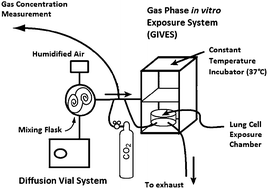Application of chemical vapor generation systems to deliver constant gas concentrations for in vitro exposure to volatile organic compounds†
Abstract
Exposure to volatile organic compounds from outdoor air pollution is a major public health concern; however, there is scant information about the health effects induced by inhalation exposure to photochemical transformed products of primary emissions. In this study, we present a stable and reproducible exposure method to deliver ppm–ppb levels of gaseous standards in a humidified air stream for in vitro cell exposure through a direct air–liquid interface. Gaseous species were generated from a diffusion vial, and coupled to a gas-phase in vitro exposure system. Acrolein and methacrolein, which are major first-generation photochemical transformation products of 1,3-butadiene and isoprene, respectively, were selected as model compounds. A series of vapor concentrations (0.23–2.37 ppmv for acrolein and 0.68–10.7 ppmv for methacrolein) were investigated to characterize the exposure dose–response relationships. Temperature and the inner diameter of the diffusion vials are key parameters to control the evaporation rates and diffusion rates for the delivery of target vapor concentrations. Our findings suggest that this exposure method can be used for testing a wide range of atmospheric volatile organic compounds, and permits both single compound and multiple compound sources to generate mixtures in air. The relative standard deviations (%RSD) of output concentrations were within 10% during the 4-hour exposure time. The comparative exposure-response data allow us to prioritize numerous hazardous gas phase air pollutants. These identified pollutants can be further incorporated into air quality simulation models to better characterize the environmental health risks arising from inhalation of the photochemical transformed products.



 Please wait while we load your content...
Please wait while we load your content...